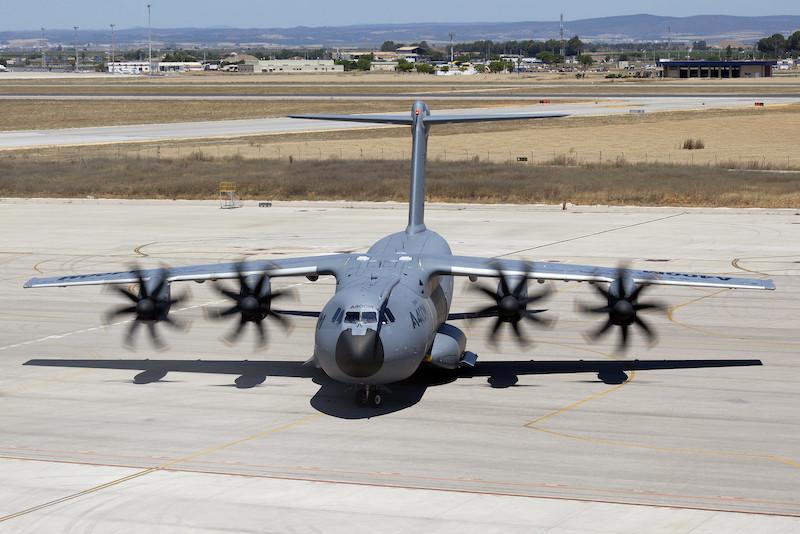
The future European airlifter would operate alongside the A400M.
Airbus is to lead a consortium of 33 companies from 12 European countries to study the potential development of a future European airlifter.
Airbus will be the co-ordinator for the Future Air System for European Tactical Transportation (Fasett) project, which is being supported with €30 million ($33 million) from the European Defense Fund (EDF) in its latest round of grants to support European industry defense research and technology development. Fasett is one of 41 European defense projects awarded grants worth a combined €832 million.
The Fasett project will “analyze the technical and market possibilities for the potential development of a new cost competitive and robust” European airlifter, the EDF’s documentation on the project states.
Fasett builds on the back of the Permanent Structured Cooperation (PESCO) project known as Future Mid-Size Tactical Cargo (FMTC). Led by France and supported by Germany, Spain and Sweden, FMTC calls for a new airlifter that could replace platforms like the Lockheed C-130, the Airbus C-295 and the Leonardo C-27J, while operating alongside the A400M.
The award of the funding from the European Commission follows statements made by Airbus Defense and Space CEO Michael Schoellhorn to Aerospace DAILY in the lead up to the Paris Air Show. Schoellhorn said industry was examining options for potential replacements of Europe’s Lockheed C-130 Hercules fleets.
“Many of these aircraft are coming toward the end of their lifespan and there is a question of what the 20-ton-class of transport aircraft looks like in the next decade or so,” Schoellhorn said.
Key aims of the Fasett study will be to find a configuration with the payload and volume capacity to accommodate new-generation vehicles used by European militaries, as many have introduced systems that do not fit on platforms such as the C-130.
A potential new platform could become a serious competitor to Embraer’s KC-390 airlifter if Europe is able to accelerate development. The KC-390 already has secured several European orders and is on target to grab more customers in the coming years.
“The Fasett feasibility study aims to carry out a cooperative analysis of the transport aircraft replacement needs of EU Member States on the 2030-40 horizon and to identify European development opportunities to address strategic gaps,” the documents state.
The companies supporting the effort alongside Airbus and its various businesses include Leonardo Aircraft, which builds the C-27J Spartan turboprop airlifter; engine manufacturers Avio Aero, ITP Aero, MTU, Rolls-Royce and Safran; and defense electronics suppliers Hensoldt, Indra and Thales. Some industry officials have described the effort as like that which developed the Transall airlifter in the 1960s. Indeed, the Fasett/FMTC effort will be looking to replace platforms of that size.
EDF funding also will support the next step in the Responsive Electronic Attack for Cooperation Tasks (REACT) project, to the tune of €40 million. REACT has been undertaking research efforts into the potential development of a European escort jamming and electronic-attack capability. Under the second stage of the project, known as REACT II—led by Spain’s Indra—industry will further the development of the system to perform stand-off and stand-in jamming, electronic warfare, command and control, and cyber and electromagnetic activities.
The EDF also will support the second iteration of Odins Eye. This project aims to develop a space-based early warning system to deal with ballistic, hypersonic and even anti-satellite (ASAT) threats.
Odins Eye II is a component of the PESCO Twister—short for Timely Warning and Interception with Space-based TheatER—project aimed at developing a European hypersonic defense system.
The Odins Eye efforts are being led by German satellite company OHB with support from companies including Airbus, Ariane Group, Hensoldt, Leonardo, MBDA, Terma and Thales Alenia Space.
Funding also is supporting early studies into the creation of a next-generation quiet hypersonic wind tunnel, codenamed Silent. Led by France’s Onera research agency, Silent is being supported by €4 million of EDF funding.
The EDF also is supporting research into swarming drone and the protection of uncrewed aircraft systems from rain and icing.
“The EDF is a strong contribution to Europe’s freedom of action, technological leadership and more integrated European defense industrial basis,” says Thierry Breton, the European Commission’s commissioner for the internal market. “The projects undertaken this year demonstrate that European member states, through effective cooperation, are building a stronger European defense.”






Comments